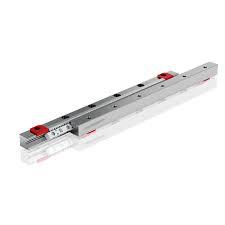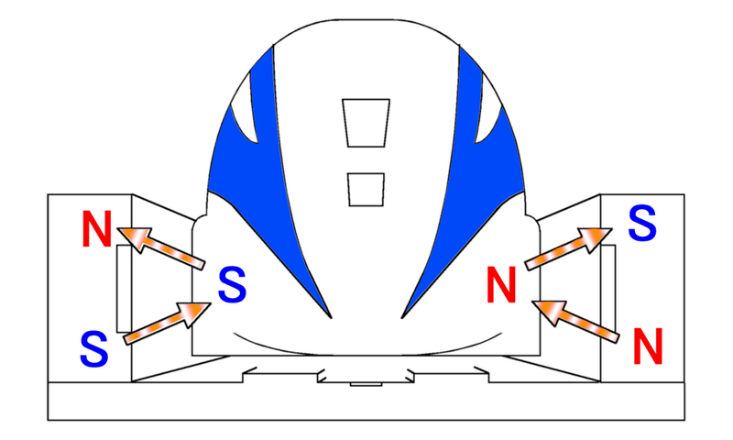Hi there, Mecatronitians!
Welcome to another issue of the SINADRIVES blog
January 2021
In our everyday lives, the movement of any object in space must be guided, otherwise it would just fall onto the floor. The sliding door to your office, the moving carriage on a linear stage, or the protective door of a milling machine are all examples of guided movements. The main function of a guide is to restrict the degrees of freedom of a given moving object. Today we are going to talk in general terms about the linear guides used in the industry. Thanks to the extensive offer available on the market, linear guides are now affordable to many budgets.
Linear guides can be divided in two main groups: contact linear guides (when there is physical contact between the guide and the block) and contactless guides (when there is no contact between the two parts). The big difference between them is the wearing of the contact guides and their requisite maintenance.
1. Contact linear guides
1.1. Linear guides with roller bearings
There are several types of linear guides with roller bearings: flat roller guides, Gothic arch guides, and V-type guides. These are rails for any type of guided movement, ensuring ease, affordability and low maintenance (see Picture 1). One of the main features of such systems is their robustness, as dirty environments won’t affect their good functioning. Another feature is their alignment, since their mounting surface does not need to be precise, i.e. they accept misalignments, a fact which simplifies both the workbench set-up and the mounting and adjustment process. They also have remarkably low maintenance, since they still work relatively well even when the guide is not sufficiently greased. The downsides include their low precision, poor rigidity, the appearance of slacks after servicing time, and the short service life when put in dynamic applications, since the high accelerations impede the correct movement of the rollers. Due to its moment of inertia, the roller slides on the surface instead of rolling, thus causing additional wear on the start and braking points.

Picture 1: Linear guide with roller bearings. Source: Hepco
1.2. Linear ball bearing guides
This type of guide is very popular nowadays thanks to its simple mounting. The standardisation of sizes and measurements among different manufacturers has made them easily interchangeable. Furthermore, they come with very competitive delivery times and prices.
There are currently two types of recirculating linear roller guides: bushing guides (which require a cylindrical calibrated bar), and ball guides with blocks, which are more widely used by machine manufacturers. The advantages of these types of guides include their load capacity, improved rigidity, outstanding precision and long service life (see Picture 2). Assembling these guides is easy, since their compact size means they don’t take up much space on a mounting workbench. One interesting option is the ball chain: this is a divider that guarantees that the balls inside the block don’t come into contact with each other, therefore reducing noise, wear and maintenance. Guides are recommended for high-speed applications, but even more so in high-acceleration up to 100 m/s2. There are different coating options and a wide range of shutter types for demanding uses, such as in the food industry. Their downsides include the need to mount this system on a precise workbench. If this can’t be guaranteed, the applications involving two parallel guides may cause blockages or sliding with strong resistant forces; indeed we mustn’t forget that maintenance is key and a recirculating ball guide with no grease will not work properly due to premature wear.

Picture 2: Recirculating ball guide. Source: Bosch Rexroth
1.3. Linear roller guides
As for this type of guide, there are two subclasses: prismatic block guides and cross roller guides, the former being quite common in machine tool applications. Thanks to their stiffness and precision, recirculating ball bearing guides offer outstanding performance in the most demanding mechanisation applications. They are easy to mount and adjust, making them very popular among heavy machinery manufacturers. On the downside, a very precise workbench is required if we are to align two parallel guides. Furthermore, working speeds can’t go above 2 m/s (see Picture 3/4).
Cross roller guides are well known for their minimal “slip stick” effect. The absence of shutters allows a resistance force below 1N. To prevent the rollers from slipping, some manufacturers offer a chain to ensure the rollers move in sync with the guide. These types of guides are regularly used in applications with short strokes between 0 and 300 mm, and, as with the other bearing guides, require a high-precision workbench for mounting. Mounting is a delicate matter as they require very precise fine-tuning via a high-precision adjusting from one side of the guide. Incorrect adjustment may cause premature wearing due to excessive preload.

Picture 3/4: Linear roller guides: prismatic block guide (left, source: THK) and cross roller guide (right, source: Schneeberger)
1.4. Friction guides
These are possibly the oldest guides in engineering history. Nowadays, thanks to modern synthetic materials, there is an extensive range of this type of guide available at very low cost. These guides are commonly applied to systems with little movement, such as format adjustment. Some manufacturers’ solutions become less robust when working in environments with dirt, dust or other aggressive elements. However, this type of guide offers outstanding performance at low speeds. Their load capacity is high and proportional to the contact surface, meaning this surface will need to be enlarged in the case of heavy loads. An additional advantage of the polymer friction guide is that it does not require any maintenance as it works dry, indeed the presence of grease may cause premature wearing. Some drawbacks are related to friction itself: the friction coefficient is, in most cases, above 0.2µ, and this requires larger operating mechanisms to be built as one fifth of the force is lost in the friction process. High-speed applications can’t be designed with friction guides, as these wear quickly. These guides show some degree of clearance, and, if compensated for, the outcome is more friction and further wearing (see Picture 5).

Picture 5: Friction guides. Source: Igus
2. Contactless guides, with no wearing or maintenance
2.1 Air bearings
This type is the simplest of all from the point of view of tribology. The block levitates above the surface and thus offers a friction coefficient of 10-7 and up to 300 m/s2 in acceleration, making it very apt for dynamic applications. Another big advantage is precision: if the surface of the mounting bench is precise and flat to a high degree (we remind readers that granite workbenches are the most suitable to assemble these types of guides). These guides offer outstanding precision in their movements. The air pressure may vary between 5 and 6 bars, which is available in almost every industry sector nowadays (see Picture 5). Under this pressure, the block levitates above the surface at around 2-5 microns. The most well-known advantage of this guide is that, as there is no actual wearing, it does not require any maintenance. This results in a guide capable of enduring the harshest working conditions. We may highlight applications with very short strokes in test machines, even movements of just several microns, as well as high-frequency and high-dynamic movements. Among the disadvantages, we could highlight the need for a completely flat, roughness-free surface (meaning it must be rectified at regular intervals) which is also stable in terms of temperature and deformations.

Picture 6: Air bearings. Source: SINADRIVES
2.2. Hydrostatic guides
This type of guide is very popular in machinery tool applications. The space between the guide and the block is filled with a thin layer of oil. It seems to work as a friction guide but without any physical contact. This technology demands a good mounting surface and precise adjustment to ensure correct operation. It is a wearless, high-precision guides. Its most significant benefits are its high cost and low market offer, which makes it quite unknown among many engineers and OEM manufacturers (see Picture 7).

Picture 7: Hydrostatic guide. Source: INA Schäffler
2.3 Electromagnetic guides
This type of guide works according to the magnetic levitation principle. There are different repelling poles which account for a constant gap among the guide and the block, meaning the moving object is suspended magnetically. These guides are normally used in a clean room or vacuum applications, where other types of guides can't be accepted. The biggest disadvantage of such guides is their price, which is much higher than for the other types (Picture 8)

Picture 8: Electromagnetic guides. Source: SINADRIVES
3. Summing up the main features
Table 1 below shows the main features of the described linear guides, comparing them in terms of performance, cost, assembly, etc.
| Properties | Roller guide | Ball guide | Recircul. Roller guide | Friction guides | Air bearing | Hydrostatic guide | Electromag. Guide |
|---|---|---|---|---|---|---|---|
| Rigidity | - | + | ++ | + | + | ++ | + |
| Velocity | + | + | 0 | - | ++ | 0 | ++ |
| Acceleration | - | + | 0 | + | ++ | 0 | ++ |
| Load capacity | + | + | ++ | ++ | ++ | ++ | + |
| Precision | - | + | + | 0 | + | ++ | + |
| Ease of mounting | + | + | 0 | + | - | - | - |
| Maintenance | + | 0 | 0 | + | ++ | + | ++ |
| Cost | + | + | 0 | + | - | - | - |
Table 1 – Comparison of the main features of linear guides, where – low feature, 0 average features, + high feature and ++ exceptionally high feature
That’s all for today. We hope this review of guides has been interesting, and we look forward to seeing you in the next chapter.
If you wish, you may leave your comments below and subscribe to our blog so you don’t miss any publications.
We wish you all the best in 2021.
The SINADRIVES Team






Get Social